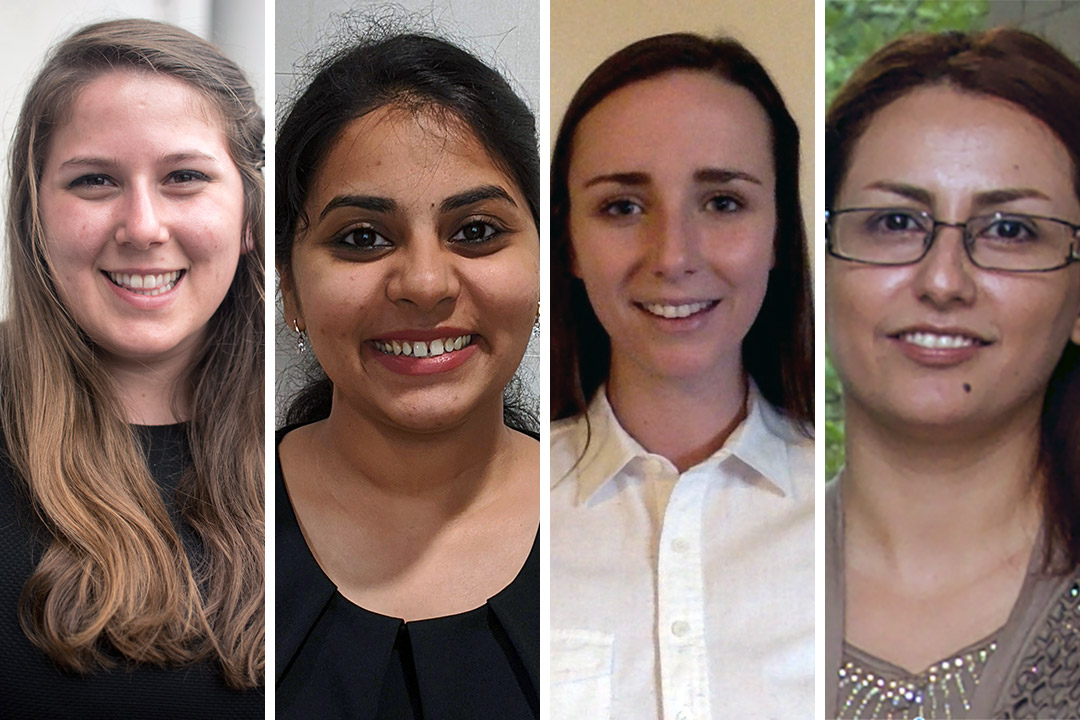RIT doctoral students set to contribute to health care, imaging and space fields
University continues to grow its doctoral programs and graduate numbers
Alyssa Owens, Poornima Kalyanram, Karen Soule and Fatemeh Shah-Mohammadi are on track to graduate with a Ph.D. in engineering, one of RIT’s newest doctoral programs.
Alyssa Owens is contributing new ways to diagnose breast cancer and Poornima Kalyanram has discovered how fluorescent molecules might help to identify diseased cells. Karen Soule and Fatemeh Shah-Mohammadi are part of breakthrough work in developing carbon nanotubes and cognitive radio networks—advances in technology that will power tomorrow’s electronic devices.
They are only a small sampling of the doctoral students RIT will honor this spring. All four are on track to graduate with a Ph.D. in engineering, one of RIT’s newest doctoral programs. In 2018-2019, 35 doctoral degrees were conferred overall. This academic year, 49 people are projected to be defending dissertations and completing degrees, contributing to the growing national trend of graduates in the important STEM fields.
For RIT’s doctoral students, the environment consists of exciting but rigorous programs, strong faculty mentors and a diverse, intelligent group of students, said Owens, whose research involves a steady-state infrared imaging approach for breast cancer screening.
“The engineering program at RIT has grown very rapidly, so there is now a vast network of students, from all different backgrounds and walks of life, that I can connect with,” she said. “RIT has several mixers throughout the year either for engineering specifically or for all Ph.D.s. Within the Ph.D. program, I can connect with those that are facing the same issues and celebrating the same milestones as me. But I also have friends outside of the program who can help keep me grounded, distract me when I'm stressed and help me maintain that work-life balance.”
Owens, who is originally from Queensbury, N.Y., expects to continue work in research and development, specifically in the area of biomedical device development.
When the Ph.D. in engineering was established in 2014, Shah-Mohammadi was in the first cohort. She started doing research on sustainable LTE networks. But after two years, she learned about machine learning and artificial intelligence and their broad application in realizing intelligent wireless communications in future. So she switched her area of research in her last years of studies.
“I always wanted to be an academician and share my knowledge and also learn from others,” said Shah-Mohammadi, who is from Iran.
She is pursuing a postdoc and industry experience. She’d eventually like to be a faculty-researcher in academia.
“In fact, attending a Ph.D. program in the United States was a top goal to equip myself with the most up-to-date research in the industry.”
Kalyanram agreed.
“Growing up, I was always fascinated by technology and I wanted to be a scientist. Professors and mentors in my undergraduate and master’s courses encouraged my curiosity, and this led me to consider Ph.D. programs after I graduated.”
She said her goals were twofold. She wanted to conduct research that could have practical applications that helped improve human life and set herself up for a long-term career as a scientist at a university or research-focused pharmaceutical or healthcare company.
“Things seem to be on track so far, and I am in the process of applying for post-doc and scientist positions in pharmaceutical companies,” said Kalyanram, who is from India.
Soule is also searching for materials engineering positions in industry and would like to work at a company developing technologies and solutions for living and operating on the moon, and someday, Mars.
“The RIT community has exposed me to innovations regarding various access technologies, development of sustainable cities, as well as novel materials research, which have provided me with diverse perspectives that will guide me through my career and entrepreneurial endeavors,” said Soule, who is from Pulaski, N.Y.
Her research involves using carbon nanotube conductors as lightweight and strong alternatives to conventional metal wires. Chemical dopants have been used to improve the electrical conductivity of these CNT conductors, she explained, and her work focuses on understanding how these chemically-doped CNT wires can withstand long-term operation under high current load. Solutions can improve electronic device development exponentially.
“Early in my undergraduate career, I realized that rather than maintaining standard operations, I wanted to create new processes needed to solve the grand challenges of space, sustainability, and society,” she said. “As a Ph.D. student, my goal has been to become a better innovator and problem solver while experiencing the widest variety of opportunities possible.”
About RIT’s doctoral programs
The university offers eight doctoral programs, and its first was conferred in 1993 in imaging science. Currently, nearly 400 students are enrolled in programs in mathematical modeling, color science, sustainability, astrophysical sciences and technology, microsystems engineering, imaging science, computing and information sciences and engineering.













